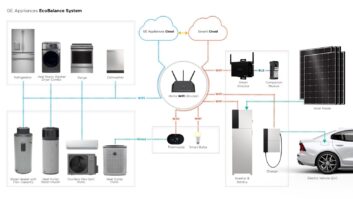BENTONVILLE, ARK.
– It’s been vilified by labor unions, planning boards, social
commentators and competitors, but for many American shoppers, Walmart is a
lifesaver.
That’s no less true in CE, where the world’s largest
retailer continues making technology more affordable as categories like
computers and mobile move from luxury to necessity.
But for the past five years, the discounter has been
reaching out to a more aspirational customer by bringing in
tier-one brands and advanced technologies, including LED TV and 4G smartphones this
season, and 3D TV this fall.
In the process, the chain has rocked the CE boat by
redrawing the boundaries between retail distribution channels and the impact
has been profound: Manufacturers are finding a new conduit for their factory
output; specialty dealers are feeling betrayed and threatened by the brands
they helped nurture; and industry observers foresee greater pricing pressure on
a sector that already devolves from innovation to commodity at alarming rate
[see analysis, p. 22].
Stephen Baker, industry analysis VP for The NPD Group,
believes Walmart’s transformation from commodity outlet to name-brand
destination gained momentum with the recession. “Vendors had been skeptical
about Walmart’s ability to execute, and exhibited a certain geek elitism,” he
observed. “But then Circuit City went out, the economy dropped, and the Walmart
model started looking better to manufacturers.”
aker’s theory is borne out by NPD research showing that
Walmart, along with CE archrival Best Buy, were the biggest beneficiaries of
Circuit City’s demise, having captured two-thirds of that chain’s dollar share
from March 2009 through last December.
Mike Decker, electronics marketing senior VP for
Nationwide Marketing Group, the $12 billion independent dealer organization,
believes Walmart’s goal is a 25 percent share of the CE market, putting it in
“a horse race” with Best Buy. If true, Bentonville has its work cut out for it.
According to the latest TWICE Top 100 Retailers Report, Walmart’s $18.5 billion
in annual CE sales represents 15 percent of the ranking’s total revenue,
compared with Best Buy’s 24.7 percent share.
Dave Workman, executive director/COO of the Progressive
Retailers Organization (PRO Group), a collective of independent A/V specialty
dealers, agrees that Walmart’s up-market aspirations assumed an added urgency
during the economic downturn, as its core customer found it harder to make ends
meet.
“Walmart was the beneficiary of higher-income consumers
migrating down during the recession,” he noted. “The question for them is how
to hold onto that demographic when the economy improves.”
For its part, Walmart said it draws a wide swath of
consumers of all incomes, and strives to provide value at every level. “A good
core of our customers operate paycheck to paycheck, but not all do,” said Gary
Severson, Walmart’s home entertainment senior VP. “Some are saving for a
special purchase. Customers shop us at every price point, and we seek to offer
value whether it’s a tier-one or value brand.”
Severson said the CE initiatives, like most of Walmart’s
merchandising decisions, were made in the service of its customers,
particularly women. “While CE specialty stores have a predominantly male
customer, our breadth of assortment gives us a large customer base of women,”
he explained. “And our research showed that female customers want great brands,
which they equate with quality, as well as great value.”
Also driving Walmart’s CE evolution is an increasingly
sophisticated consumer who researches products online and views instructional
videos on YouTube. “The emergence of a more knowledgeable customer empowered by
the Internet is tightening the technology cycle of specialty retailer to mass
merchant to discounter,” he observed.
Still, bringing limited-distribution brands to a discount
floor was, and remains, an uphill battle for Severson’s team. “We needed a good
strategy, and did a lot of work trying to understand our customer and how
technology has evolved,” Walmart’s chief CE merchant recalled. “As the customer
became more and more engaged in technology, we had to focus more on how we were
engaged in the products, presentation, brands and suppliers, and how that was
messaged while staying within our own brand.”
Some vendors responded faster than others to Walmart’s
vision of what it wanted to become, and some, he said, are still watching and
waiting. “But over the years we’ve had pretty good success bringing brands in.
Through teamwork and education we’ve been able to establish good
relationships.”
One of the oldest is with Sony Electronics, which traces
the partnership back to legacy products like the Walkman. “As their business
evolved, so has our relationship,” said Ken Stevens, Sony’s consumer sales
senior VP. “Walmart knows who they are better than most and, like Sony, understands
its customer. That makes it pretty easy to map the intersection points where we
can be relevant and successful together.”
Severson described his prototypical CE shopper as “a
practical adopter of technology who may not want to know all the bits and bytes
of technology. They want it to be a part of their lives, but they want it to be
as easy as possible.”
To that end, Walmart works with manufacturers “to drive
as simple a communication and
experience as we can,” and backs that up with “a lot of basic training,”
provided by suppliers via an online learning tool called Cyber-
Scholar. Once home, he said, customers can call supplier hotlines, purchase
home-theater installation and IT services through a recent initiative with NEW,
or find what they need online.
Looking ahead, Walmart will continue to drive a better,
richer and simpler CE experience as technology becomes increasingly embedded in
consumers’ lives, Severson said. “Hopefully Walmart will be an important part
of that.”













